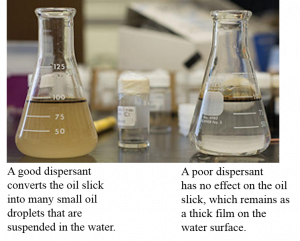Winter 2019 – GoMRI Researcher Interview with Dr. Srinivasa Raghavan
– DECEMBER 18, 2019
(From Winter 2019 Newsletter) Dr. Srinivasa Raghavan from the University of Maryland’s Department of Chemical and Biomolecular Engineering answered a few questions about his work as a co-principal investigator with the Consortium for the Molecular Engineering of Dispersant Systems (C-MEDS) and his RFP-V project, Molecular Engineering of Food-Grade Dispersants as Highly Efficient and Safe Materials for the Treatment of Oil Spills.
1. What is your background and how did you get involved with this kind of work?
My background is in the field of colloid science, which nowadays is synonymous with “nanoscience.” This field deals with materials such as emulsions. When an oil spill is cleared, oil droplets get suspended in the seawater, thereby creating an oil-in-water emulsion. To stabilize this emulsion, it is necessary to have certain molecules, called surfactants, on the surfaces of the droplets.
I got into the area of oil spills when Professor Vijay John from Tulane University first created the C-MEDS consortium to address the oil spill that arose in the Gulf of Mexico in 2010. Professor John was a true visionary in establishing C-MEDS, which was a consortium of 40 key researchers in the field. He knew of my expertise in colloid science, which is why I was included in C-MEDS.
2. Can you tell us a bit more about your involvement with C-MEDS?
In working with C-MEDS, we all learned about the current materials used to stabilize oil spills, called dispersants. We learned that current dispersants were deemed to be somewhat toxic, both to aquatic life as well as to humans who came in contact with the materials. This motivated my group to develop an alternative dispersant that was based entirely on food-grade molecules, which would then be non-toxic. We collaborated with Professor John and succeeded in creating a food-grade dispersant that was able to stabilize emulsions of crude oil in seawater. This was our principal finding, and it was published in an article in 2014 in the journal Langmuir (read more on the GoMRI website here). To our knowledge, this was the first ever example of a food-grade dispersant.
3. What is the food-grade dispersant made out of?
The key components are two molecules. One is lecithin, which is a natural component (‘lipid’) extracted from soybeans. Soy lecithin is widely used in many food products. One of these is chocolate: if you look at the list of ingredients on chocolate products, you will likely find soy lecithin listed. The second molecule is called Tween 80, and it is also used in many food products, notably ice cream. According to one study, which we cited in our paper, the average person in the U.S. consumes between 12 and 111 milligrams (mg) of this material every day.
4. Please tell us about your RFP-V research project, Molecular Engineering of Food-Grade Dispersants as Highly Efficient and Safe Materials for the Treatment of Oil Spills. What are the goals of your project?
Our initial exciting results from C-MEDS provided the backbone for our RFP-V project. In this project, we have attempted “molecular engineering” of the food-grade dispersant that we had previously created. For this project, we formed a team of four researchers: myself, Professor John, Professor Alon McCormick (University of Minnesota), and Professor Geoff Bothun (University of Rhode Island).
The idea of “molecular engineering” is to use scientific principles to select the right molecules (in the right proportions) that will give us the best dispersant. Note that the dispersant disperses the oil slick into small droplets, which then get carried below the ocean surface, where they get biodegraded by bacteria in the ocean. The more efficient the dispersant, less of it will be needed to disperse a large oil slick. This is one metric we care about. By creating efficient, food-grade dispersants, we hope to provide a viable alternative to the current dispersants used by industry.
5. What are some of the most significant or exciting findings so far in your GoMRI-funded research?
The most exciting findings from our RFP-V project fall into two categories. First, we have discovered that dispersion and emulsification are related, but not the same process. There are subtle, but important differences. We are trying to outline these differences and describe them to the scientific community. Our results will probably come as a surprise to many scientists. If we can explain these differences, it could be a big scientific achievement. Second, we have been studying the process by which bacteria biodegrade crude oil that is dispersed by our food-grade dispersant. In this regard, we have made many surprising discoveries, one of which is that the bacteria can coat oil droplets and form a biofilm. We are looking forward to publishing our work on the above topics this year.
More information on Dr. Raghavan’s GoMRI-funded research is available on the GoMRI website here, here, and here. Please also visit Dr. Raghavan’s laboratory website here.







